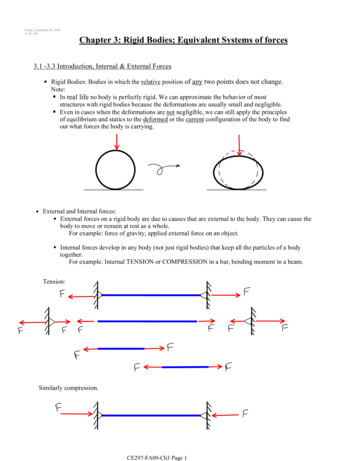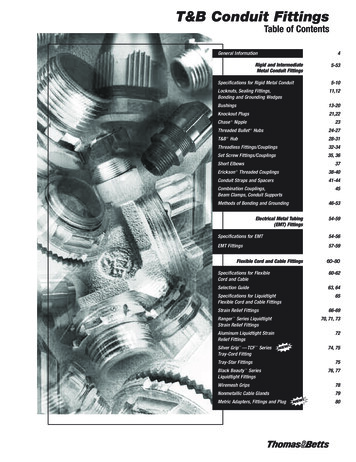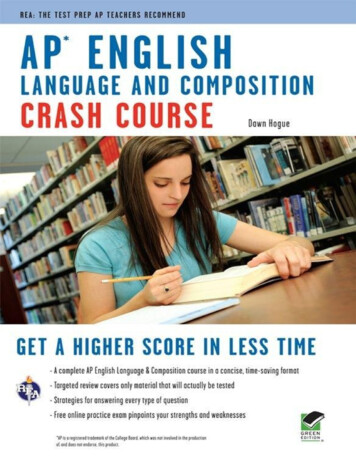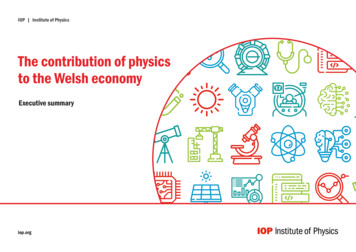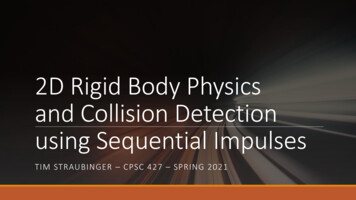
Transcription
2D Rigid Body Physicsand Collision Detectionusing Sequential ImpulsesTIM STRAUBINGER – CPSC 427 – SPRING 2021
Additional Resourceshttps://box2d.org/publications/ Materials by Erin Catto, author of Box2D physics cs-part-ian-introduction-to-rigid-body-dynamics 3-part rigid body dynamics tutorial by Nilson Soutohttps://en.wikipedia.org/wiki/List of moments of inertia lists moments of inertia for many basic shapes
Basics of Rigid Body Physics
What is a Rigid Body?A physical body (with mass, orientation, and shape) that cannot bendThe orientation is easy to describe globally (e.g. position and velocity about center of mass)and it does not depend on the shapeThe effects of forces/impulses also do not depend on the shape! These depend on the body’s inertia and moment of inertia (if using rotation), whichare influenced by the body’s mass and distribution of massThe rigid body’s shape can be ignored in all parts of the physics engine exceptduring collision detection
Describing a Rigid Body in 2DLinear PropertiesAngular Propertiesposition (2D vector, e.g. meters)angle (scalar, e.g. radians)velocity (2D vector, e.g. meters/second)angular velocity (scalar, e.g. radians/second)mass (scalar, e.g. kg)moment of inertia (scalar, kg*meters 2)
Moving a Rigid BodyIntegrating the equations of motion
What is an Impulse?Instantaneous change in momentum (where momentum is mass times velocity)Usually represented as JApplying an impulse J to a light object causes a large change in velocityApplying the same impulse J to a heavy object causes a small change in velocity
Why use Impulses?When rigid bodies collide, potentially infinite forcesare generated! Suppose that two objects are colliding, and 1 Newton offorce is needed for a time step of 1 second to keepthem separated For a time step of 0.1 seconds, we would need 10Newtons to keep them separated For a time step of 0.01 seconds, we would need 100Newtons Etc Math for solving constraints is easier compared toforces
Applying Impulses to a Rigid Body(at the Center of Mass)Linear ImpulsesAngular Impulsesinstantaneous change in linear momentumInstantaneous change in angular momentumEquivalent to force * timeEquivalent to torque * time
Applying Impulses to a Rigid Body(at any point)Achieved by splitting impulse into linear and angular terms relative to center of massThis step can be ignored if you are not using rotation
Applying Impulses to a Rigid Body(at any point)Achieved by splitting impulse into linear and angular terms relative to center of massThis step can be ignored if you are not using rotation
Collision Detection
Convex ShapesSlightly-formal definition: a shape is convex if and only if every straight line segment drawnbetween any two points inside the shape is also entirely inside the shape.Less formal definition: a shape is convex if and only if you can stretch a rubber band around itsperimeter without leaving gaps.Even less formal definition: a shape is convex if and only if you can’t drink tea out of it.ConvexNot Convex
Separating Axis TheoremTwo convex shapes are not colliding if and only if there exists aline that separates the two In other words, if you can draw a line between two convex shapeswithout touching either, then the two shapes are not colliding. Otherwise, if no such line can be found, the shapes are definitelycolliding In practice, only a few interesting lines need to be considered(such as edges)More reading:https://en.wikipedia.org/wiki/Hyperplane separation theorem
Describing a CollisionA few things are needed to describe a single collision between two rigid bodies:1.The points of collision pa and pb both bodies2.The collision normal n (e.g. the surface normal at the point of collision)3.The collision depth d (e.g. how deeply the bodies have passed into each other)The two rigid bodies involved are denoted A and B
Building Blocks: Point-Point Distance
Building Blocks: Point-Circle Signed Distance
Building Blocks: Edge-Line Signed Distance
General Approach for Convex Collision Detection1.Rotate and translate both shapes into the world coordinate frame2.Loop over all interesting edge-corner pairs between both shapes1.2.3.If that edge fully separates the two shapes, there is no collision (SAT). Return early.If the corner is outside the other shape, skip this loop iteration.Otherwise, find the tentative collision details:1.2.3.4.4.The collision point on one shape is the corner being consideredThe other collision point is simply the nearest point to the corner and the edgeThe collision normal is the edge normal at its collision pointThe collision depth is the distance from the edgeIf the collision depth is the biggest yet seen, record these collision details3.At this point, no separating axis was found and we thus have a collision4.Return the collision details for the edge-corner pair with the greatest collision depth
Circle-Circle Collision
Circle-Rectangle Collision: Edge Case
Circle-Rectangle Collision: Corner Case
Circle-Polygon Collision: Edge Case
Circle-Polygon Collision: Corner Case
Polygon-Polygon Collision: Edge Case
Polygon-Polygon Collision: Corner Case
Collision Resolutionusing Sequential Impulses
Background: Force-Based SolversNot used Sequential Impulses Find the change in acceleration needed to prevent objects from passing through each other Pros: Can bring objects stably to rest Well-studied Cons: Serious drift (no way to directly modify positions or velocities, so errors accumulate quickly) Forces become degenerate as time step is made smaller (unintuitive and numerically unstable)
Background: Impulse-Based SolversUsed in Sequential Impulses Find the change in velocity needed to prevent objects from passing through each other Pros: Easier to reason about that force-based solvers No infinite forces Can still think in terms of forces (impulse divided by time step results in force) Cons: Some drift (but it’s easier to correct for)
How to solve a (single) collision1.Find the relative velocity between the two points of collision1.2.If you’re ignoring rotation, this is simply the velocity of both bodiesOtherwise, the velocity is given by2.Project the relative velocity onto the collision normal (e.g. discard sliding motion)3.We want this velocity to become zero, which is achieved by applying an impulse
Background: Global SolversNot used in Sequential Impulses Given a set of equations describing collisions, solve them all at the same time Pros: Accurate Many available algorithms for solving systems of equations Cons: Bad at handling inequalities (collisions are represented as inequalities ) Solver algorithms are very complicated and difficult to implement Resulting systems equations are absurdly complicated
Background: Global Solvershttps://www.youtube.com/watch?v zzy6u1z l9A
Background: Local SolversUsed in Sequential Impulses Given a set of equations describing collisions, solve them one after the other Pros: Very easy to understand and implement Easily handles inequalities (and thus collisions) Cons: Requires several iterations (but so do most global solvers) Convergence trade-offs usually need to be found and tuned manually
Background: Local Solvers
How to solve many collisions using Sequential ImpulsesThe algorithm: For each collision, set the accumulated impulse to 0 For several iterations (e.g. 1 to 50): For every collision: Find the impulse needed to solve the collision (ignoring other collisions) Slight hack: add a little extra impulse proportional to the collision depth to avoid drift Add this impulse to the accumulated impulse If the accumulated impulse is less than zero, set it to zero (prevent pulling bodies together) Compute the difference in accumulated impulse from the last iteration, and apply it to both bodies
Debugging Tips
Debugging Tips Double-check which coordinate frame each point is in. Don’t mix coordinate frames without using the appropriate transformation Double-check your units (e.g. kg, meters, meters/second, degrees vs radians) Remember your high-school physics! Dimensional analysis can help rule out many bugs Visualize your rigid bodies’ physical orientations as used in your physics calculations! These can easily be different from the visual orientations if you’re not carefull Visualize your collision points and their depths This is extremely helpful for debugging collision detection
CreditsSome contents in these slides are taken from: Erin Catto’s GDC 2014 talk: “Understanding Constraints” https://box2d.org/publications/ Nilson Souto’s rigid body dynamics tutorial series: t-i-an-introduction-to-rigid-body-dynamics
2. Loop over all interesting edge-corner pairs between both shapes 1. If that edge fully separates the two shapes, there is no collision (SAT). Return early. 2. If the corner is outside the other shape, skip this loop iteration. 3. Otherwise, find the tentative collision details: 1. The collision point on one shape is the corner being considered 2.
